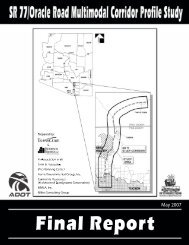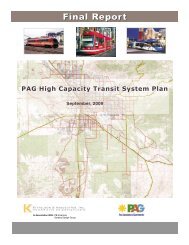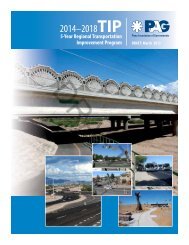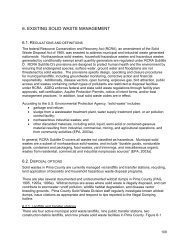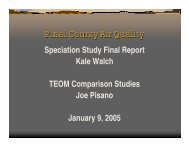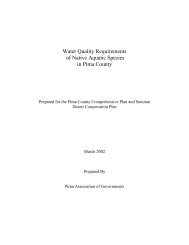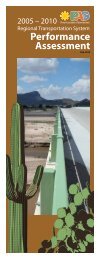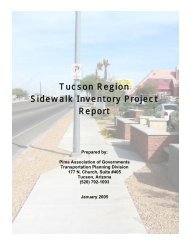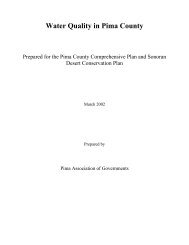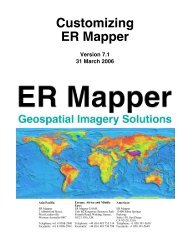Storm water discharges from construction sites
Storm water discharges from construction sites
Storm water discharges from construction sites
You also want an ePaper? Increase the reach of your titles
YUMPU automatically turns print PDFs into web optimized ePapers that Google loves.
<strong>Storm</strong> Water Requirements<br />
for Construction Sites<br />
<strong>Storm</strong> <strong>water</strong> runoff <strong>from</strong> <strong>construction</strong> <strong>sites</strong> is a<br />
major contributor to urban runoff pollution.<br />
Sediment, cement, <strong>construction</strong> waste, vehicle<br />
fluids, paints, and solvents are examples of<br />
storm <strong>water</strong> pollutants. Construction personnel<br />
can reduce or eliminate their contribution to<br />
storm <strong>water</strong> pollution by making modest<br />
changes to routine practices.<br />
The Arizona Department of Environmental<br />
Quality (ADEQ) regulates storm <strong>water</strong><br />
<strong>discharges</strong> <strong>from</strong> <strong>construction</strong> <strong>sites</strong>, including<br />
clearing, grading, and excavation activities.<br />
In accordance with the Clean Water Act and the<br />
Arizona Pollutant Discharge Elimination<br />
System (AZPDES) program, Pima County<br />
implements a storm <strong>water</strong> management<br />
program. A key element of this program<br />
includes inspection of <strong>construction</strong> <strong>sites</strong> to<br />
verify compliance with storm-<strong>water</strong><br />
requirements.<br />
Pollution <strong>from</strong><br />
Construction Sites<br />
Sediment is the most common pollutant at<br />
<strong>construction</strong> <strong>sites</strong>. Grading activities remove<br />
trees, cactus, grass, rocks, and other protective<br />
ground covers, leaving the underlying soil<br />
exposed.<br />
In doing so, the soil surface becomes<br />
unprotected and soil may be easily washed<br />
away by rain. Additional <strong>construction</strong> site<br />
pollutants include:<br />
• paints<br />
• solvents<br />
• asphalt<br />
• sealants<br />
• concrete<br />
• fertilizers<br />
• pesticides<br />
These pollutants can be mobilized by rainfall<br />
and then transported to storm drains or washes.<br />
But it hardly ever rains…<br />
Although flowing streams are rare in southern<br />
Arizona, pollutant-laden runoff <strong>from</strong><br />
<strong>construction</strong> <strong>sites</strong> may adversely impact the<br />
desert environment and clog drainage systems.<br />
Arizona State<br />
<strong>Storm</strong> Water Requirements<br />
Arizona state requirements require <strong>construction</strong><br />
site operators to obtain coverage under ADEQ’s<br />
AZPDES General Permit for Discharge From<br />
Construction Activities to Waters of the United<br />
States, dated February 28, 2008. A PDFversion<br />
of this permit may be found at the<br />
following ADEQ address:<br />
http://www.azdeq.gov/function/<br />
forms/apps<strong>water</strong>.html#cgp<br />
A fact sheet explaining the permit conditions<br />
may be found at the following ADEQ address<br />
http://www.azdeq.gov/function/<br />
forms/apps<strong>water</strong>.html#cgp<br />
To obtain coverage under the general permit,<br />
operators must file a Notice of Intent (NOI) and<br />
develop & implement a <strong>Storm</strong> Water Pollution<br />
Prevention Plan (SWPPP). As of March 10,<br />
2003, these requirements apply to all<br />
<strong>construction</strong> <strong>sites</strong> disturbing one acre or more.<br />
Notice of Intent (NOI)<br />
To obtain coverage under the <strong>construction</strong><br />
general permit, a Notice of Intent (NOI) form<br />
must be filled out and submitted to ADEQ. A<br />
copy of the NOI form may be downloaded <strong>from</strong><br />
the following ADEQ address:<br />
http://www.azdeq.gov/environ/<strong>water</strong>/<br />
permits/download/constnoi.pdf<br />
A completed NOI indicates that the operator<br />
will comply with the terms of the general permit.<br />
The NOI must be submitted at least two<br />
days before the start of <strong>construction</strong>.<br />
If the operator of the <strong>construction</strong> site<br />
changes during the course of the project, a<br />
new NOI must be submitted.
<strong>Storm</strong> Water Pollution<br />
Prevention Plan (SWPPP)<br />
The AZPDES <strong>construction</strong> general permit<br />
requires operators to prepare and implement a<br />
<strong>Storm</strong> Water Pollution Prevention Plan<br />
(SWPPP). The SWPPP must identify<br />
appropriate storm-<strong>water</strong> pollution prevention<br />
measures, or best management practices<br />
(BMPs), to reduce the amount of pollutants in<br />
storm <strong>water</strong> <strong>discharges</strong>. Information describing<br />
the basic requirements of a SWPPP may be<br />
found at the following Environmental Protection<br />
Agency (EPA) website:<br />
http://cfpub1.epa.gov/npdes/<br />
storm<strong>water</strong>/swppp.cfm<br />
A SWPPP identifies structural and nonstructural<br />
controls that will be put in place to<br />
minimize impacts caused by offsite storm <strong>water</strong><br />
<strong>discharges</strong>. The SWPPP must be implemented<br />
at the time a project breaks ground. It must be<br />
revised as <strong>construction</strong> activities proceed.<br />
A copy of the SWPPP must be kept at the site or<br />
readily available at all times. Federal, state, and<br />
local regulatory agencies have the authority to<br />
review the SWPPP at any time.<br />
Notice of Termination (NOT)<br />
ADEQ requires the filing of an NOT, which<br />
certifies that specific activities in the SWPPP<br />
have ended and that one of the following<br />
conditions is true:<br />
• final stabilization is complete and<br />
temporary erosion and sediment controls<br />
have been removed; or<br />
• all <strong>discharges</strong> <strong>from</strong> the <strong>construction</strong> area<br />
have been eliminated; or<br />
• the owner/operator has changed and the<br />
new owner/operator is responsible for<br />
compliance.<br />
A copy of the NOT form may be downloaded<br />
<strong>from</strong> the following ADEQ address:<br />
http://www.azdeq.gov/environ/<strong>water</strong>/<br />
permits/download/constnot.pdf<br />
FOR MORE INFORMATION—<br />
U.S. Environmental Protection Agency:<br />
Environmental Information Center<br />
1-866-EPA-WEST<br />
http://www.epa.gov/region9/<strong>water</strong>/npdes/<br />
storm<strong>water</strong>.html<br />
Arizona Department of Environmental<br />
Quality:<br />
Christopher Henninger / 602-771-4508<br />
http://www.azdeq.gov/environ/<strong>water</strong>/permits/<br />
storm<strong>water</strong>.html<br />
Pima County Department of Environmental<br />
Quality:<br />
Bill Petroutson or Marc Herman /<br />
520-243-7400<br />
http://www.deq.pima.gov/<strong>water</strong>/<br />
stwmgmprog.html<br />
City of Tucson / <strong>Storm</strong> Water:<br />
http://dot.tucsonaz.gov/storm<strong>water</strong>/<br />
STORM WATER<br />
REQUIREMENTS FOR<br />
CONSTRUCTION SITES<br />
IN UNINCORPORATED<br />
PIMA COUNTY<br />
Pima County<br />
Department of Environmental Quality<br />
33 North Stone Avenue, Suite 700<br />
Tucson, Arizona 85701<br />
520-243-7400<br />
http://www.deq.pima.gov/<strong>water</strong>/<br />
stwmgmprog.html



